For several hundred years the term “desk” implied something portable, even when fitted with small drawers and made large enough to store several books and various writing tools.
The word “desk” originated from the Modern Latin word “desca” which means “table to write on”, from the mid-14th century. The word desk has been used figuratively since 1797.
Eventually, desks were provided with stands and could sometimes be confused with a new type of furniture known originally as an “escritoire”, or “scriptor” (from the Latin word to write) designed primarily for writing. This new type of furniture was originally made much like a legged cabinet, the front of which folded down to provide a writing surface frequently lined with wool, hence the name “bureau” from the French word bure, meaning wool.
By the 18th century, a bureau and a desk were essentially the same items, and with the introduction of larger pieces that included shelving or other storage spaces above the writing surface, the bureau-cabinet was born.


Refinements to the first desk forms were considerable through the 19th century, as steam-driven machinery made cheap wood-pulp paper possible towards the end of the first phase of the Industrial Revolution. This allowed an increase in the number of white-collar workers. As these office workers grew in number, desks were mass-produced for them in large quantities, using newer, steam-driven woodworking machinery. This was the first sharp division in desk manufacturing.
A one-piece school desk was designed and patented by Anna Breadin in the late 1880s. It was built with a table section attached in front of a wooden seat and backrest. Before this, most students in America sat either on chairs or long benches at long tables.
A small boom in office work and desk production occurred at the beginning of the 20th century with the introduction of steel desks to take heavier loads of paper and withstand the pounding meted out on the typewriters. This also gave rise to the Typewriter Desk: a platform, sometimes on wheels and with expandable surfaces via flaps that were built to a specific height to make typing easier and more comfortable than when using a standard or traditional desk. The L-shaped desk also became popular, with the “leg” being used as an annex for the typewriter.
This furniture design development led to a much-increased demand for more attractive, functional workstations to accommodate telephones, typewriters, and space for paper files. Comfort became more of a concern and so the quality of the furnishings used improved with the launch of products like Marcel Breuer’s tubular-steel desk developed in the 1930’ and Herman Miller’s “Home Office Desk” launched in 1947. These are still considered an iconic office furniture design classic, and the first modern workstation.
The famous Wooton desk and others were the last manifestations of the “pigeonhole” style. The surfaces of some newer desks could be transformed into many different shapes and angles and were ideal for artists, draftsmen, and engineers.
Technology and Office Furniture Design
As technological advancements revolutionized the workplace, with Fax machines becoming commonplace and PC’s replacing typewriters, the office landscape was required to alter dramatically. Over time, workplaces became less rigid and as the partitions came down to encourage collaboration, office furniture design played a major role in radically changing how the workplace not only looked but also how people worked.


Office furniture design focused on creating products that were not only ergonomically conscious but also facilitated increased collaboration amongst staff. Long bench style workstations without dividers became the norm as employees once again began to sit beside and face across from one another. Workstations and seating emphasized posture and used new features to ensure correct posture in the use of new desktop PC monitors.
Moving in the new century, office furniture design was entering a golden era as advances like Wi-Fi and lightweight laptops allowed for radical changes to be introduced. Wi-Fi, for example, meant that cable management solutions were no longer as important as they once had been for furniture designers, while thinner, lightweight technology meant that workers needed less space. Together these advances increased flexibility and allowed workers to work from anywhere in the workplace (and beyond), meaning that office furniture for other areas of the workplace became increasingly important.
The first famous person who used standing desks while working was Leonardo da Vinci who lived and worked at the turn of the fifteenth and sixteenth century. Extremely much has happened since then...
Today, in the 21st century, we have a lot of solutions due to office furniture. The newest boom of standing desks started in the late 2000s. Now a lot of offices are equipped with electrically adjustable standing desks that are for both sitting and standing.





